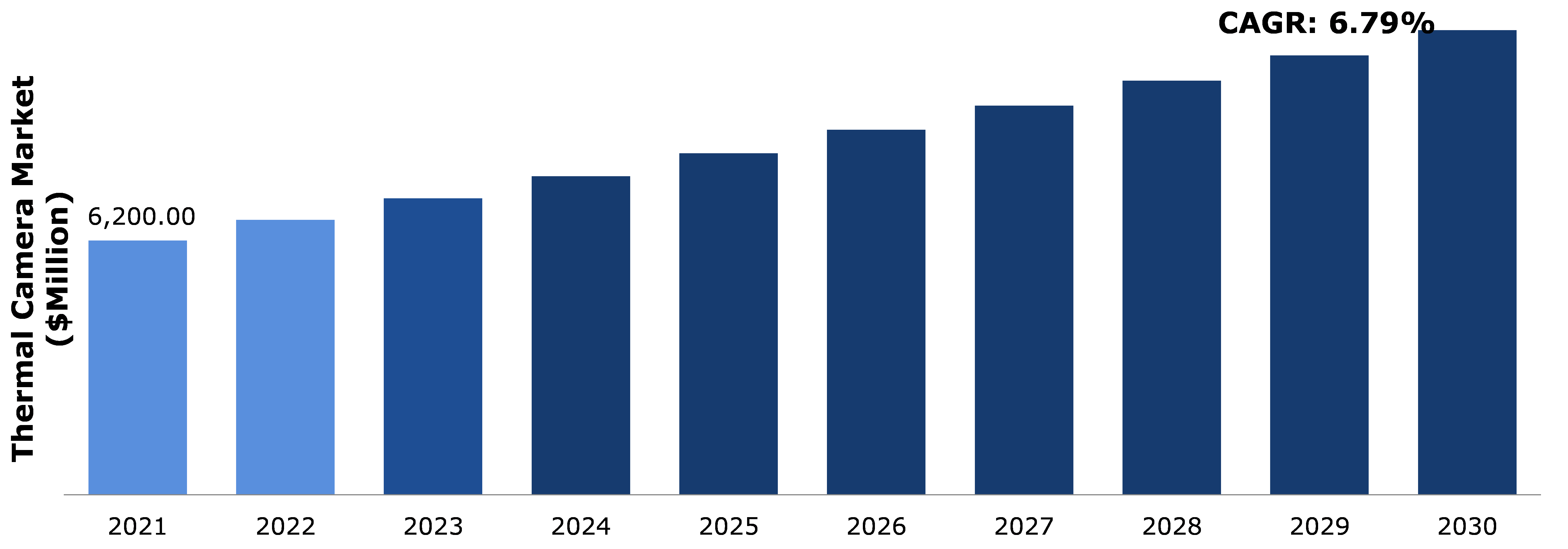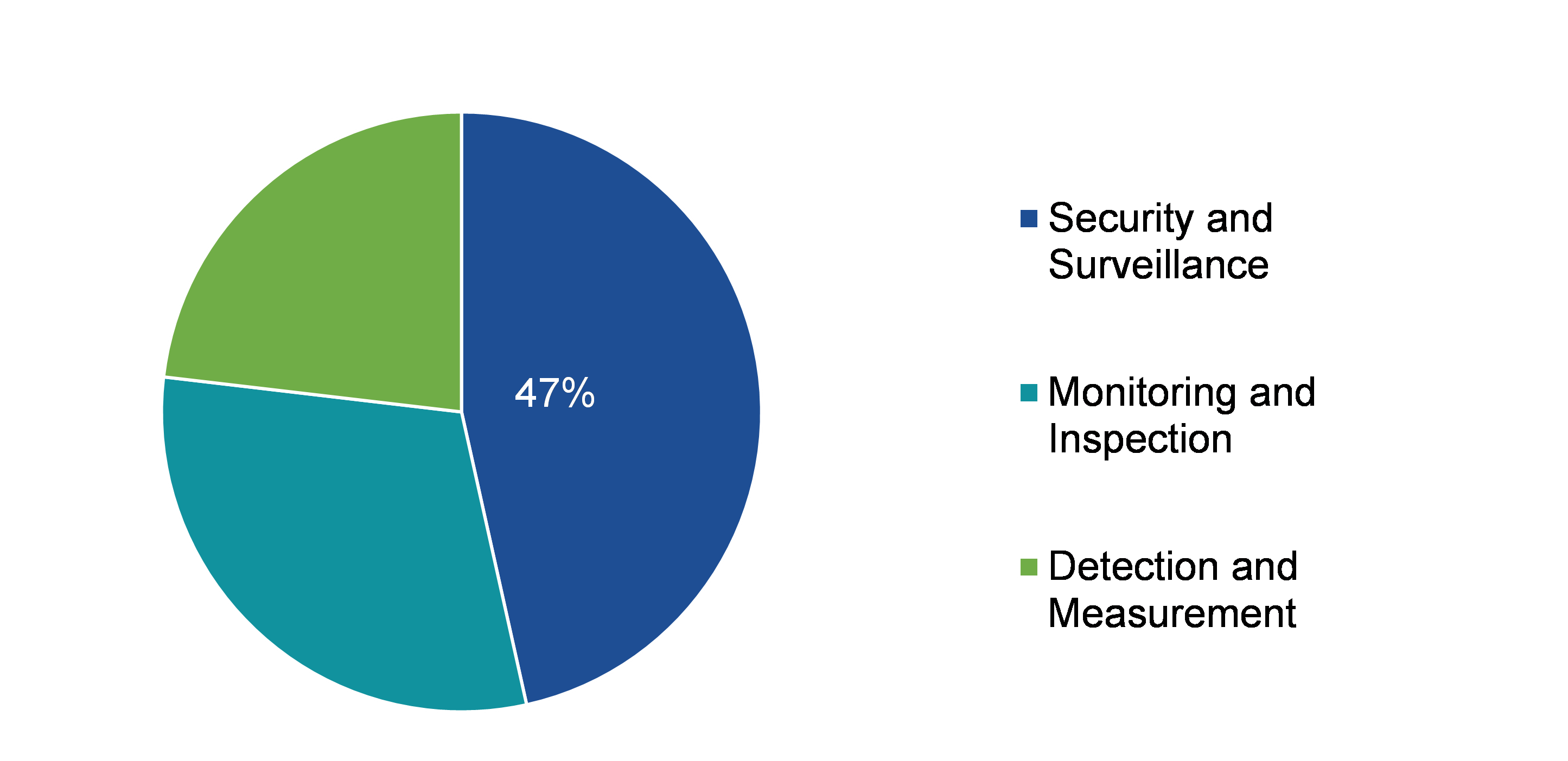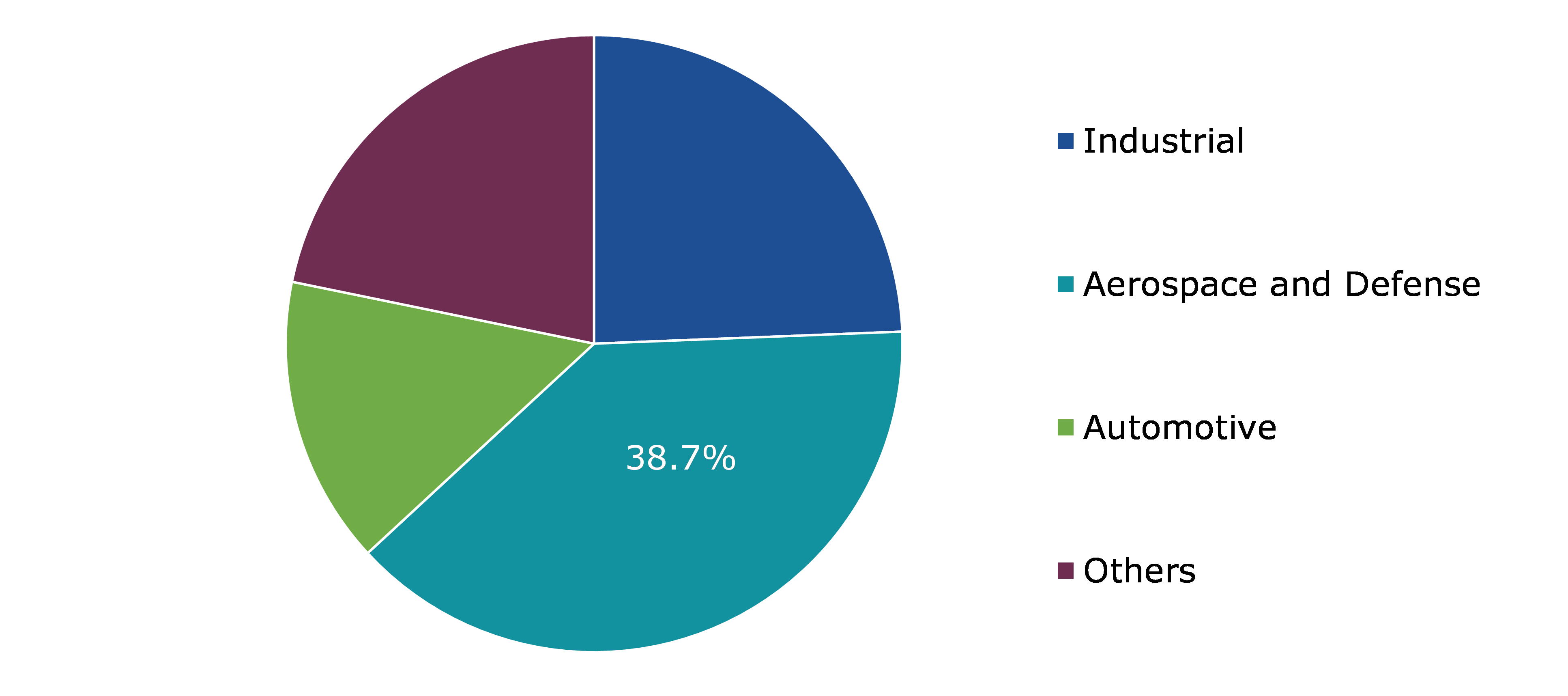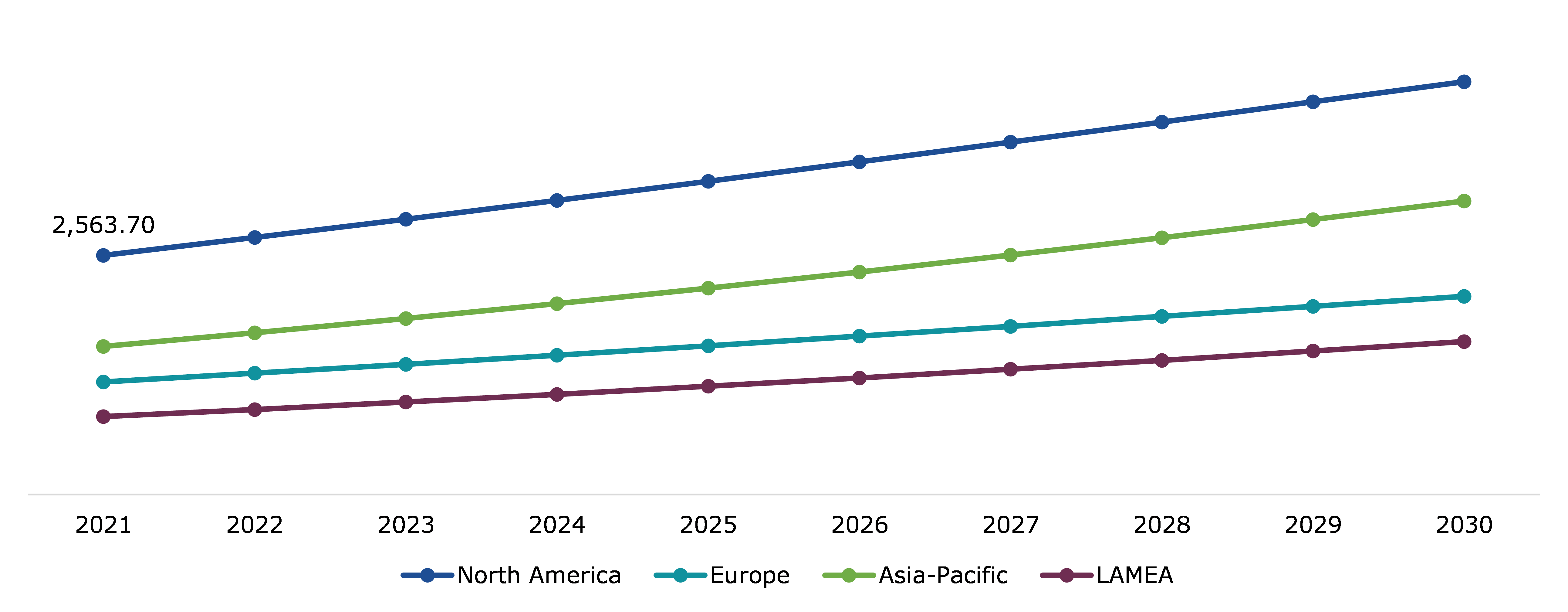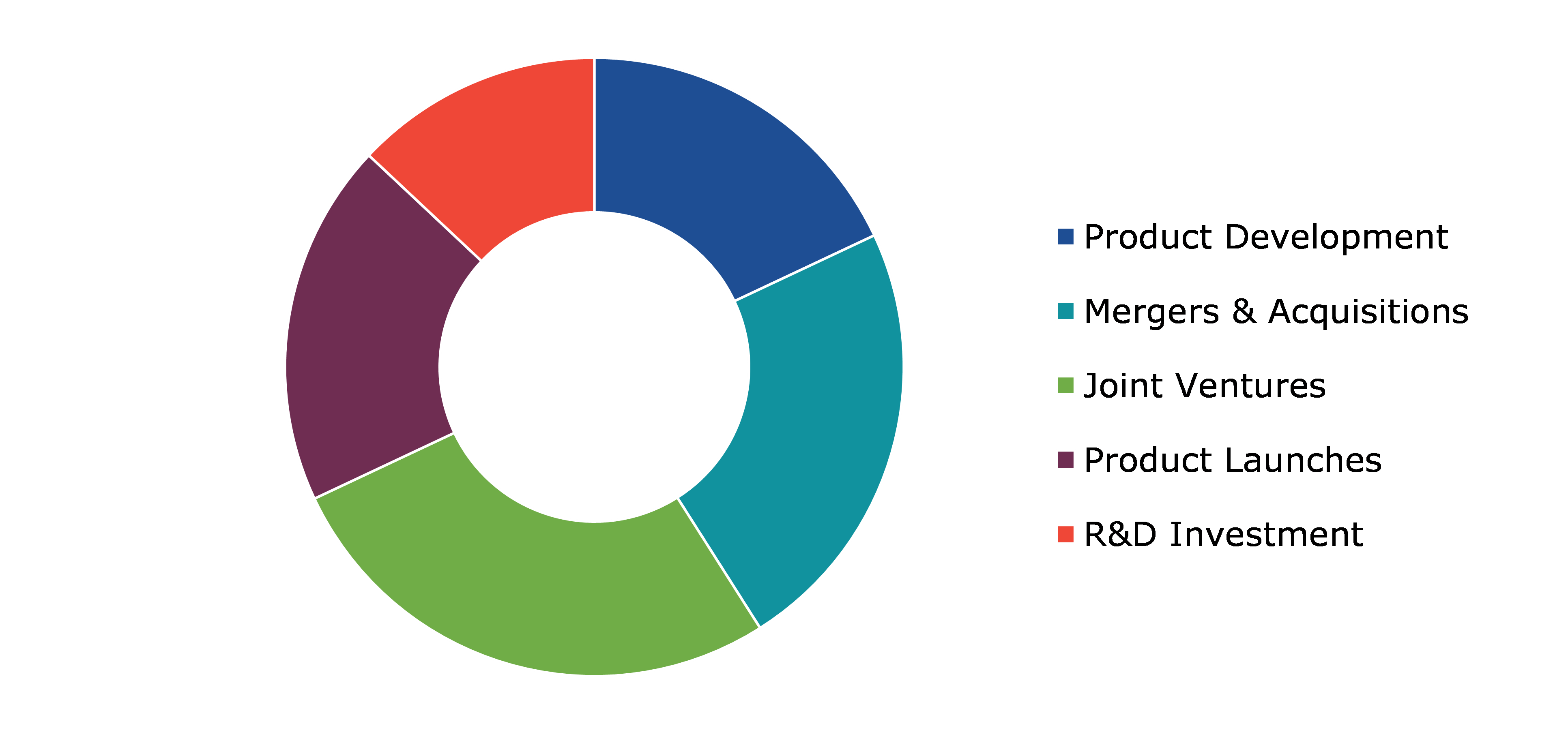Thermal Camera Market Report
RA05141
Thermal Camera Market by Product Type (Handheld Cameras and Standstill Cameras), Application (Security & Surveillance, Monitoring & Inspection, and Detection & Measurement), End-use (Industrial, Aerospace & Defense, Automotive, and Others (Law Enforcement, Healthcare, and Marine), and Regional Analysis (North America, Europe, Asia-Pacific, and LAMEA): Global Opportunity Analysis and Industry Forecast, 2022-2030
Global Thermal Camera Market Analysis
The global thermal camera market size is predicted to garner a revenue of $11,332.2 million by 2030, growing from $6,200 million in 2021, at a healthy CAGR of 6.79%.
Market Synopsis
A thermal camera is a non-contact equipment that senses infrared energy (heat) and changes it into a photographic image. Increase in demand for thermal cameras among the automotive and healthcare sectors is projected to drive the global thermal camera market revenue growth. Increasing demand for advance thermal imaging solutions in end-use verticals such as the military & defense sector and healthcare & life science sector is driving the market forward.
Export restrictions on thermal imaging cameras imposed by the U.S. Government are expected to restrain market revenue growth throughout the predicted period. Under these restrictions, manufacturers of thermal cameras will be banned from selling their products to buyers in the U.S. or out of the country without first attaining an export license, and if they fail to obey with the rules they will face penalties.
During the forecast period, increased R&D activities by key market players and technological advances in thermal cameras are expected to drive revenue growth of the thermal camera market.
According to the regional analysis of the market, the Asia-Pacific thermal camera market share is anticipated to grow during the review period. Increasing military budget to revolutionize the country’s military armaments, is predicted to drive revenue growth of the market in the region. For instance, currently, China is the second-largest country across the world with a significant military armaments budget.
Thermal Camera Overview
Thermal imaging is the process of using Infrared (IR) radiation emitted from an object to capture and construct an image of the object using a thermal camera. Thermal imagers use heat instead of visible light to produce images. Although, heat (also referred as heat energy or infrared) and light are both components of the electromagnetic spectrum, a camera that can identify visible light cannot detect thermal energy and vice versa. Thermal cameras collect IR energy and convert it to analog or digital video outputs to create images. Thermal cameras, which were originally developed for surveillance and military operations, are now widely used for building inspections (insulation, moisture, insulation, roofing, and others), firefighting, autonomous vehicles & automatic braking, skin temperature screening, industrial inspections, scientific research, and other applications.
COVID-19 Impact on Thermal Camera Market
The thermal camera industrial supply chain was disrupted due to the COVID-19 pandemic. Supply chain interruptions and manufacturing plants shutdowns were experienced by several organizations, causing production to be delayed by several weeks. One reason is that a complete thermal camera includes materials from a range of suppliers all over the world, such as focal plane arrays or read out integrated circuits, lenses, retinas, packaging, and other components. Furthermore, most businesses were shut down completely at the start of the outbreak, and it took time to get back things to normalize and rigorous measures were implemented to protect people returning to work.
However, due to the demand for thermal imaging solutions that can detect temperature from far, demand for thermal cameras has increased which resulted in a moderate effect on the overall market revenue growth.
Rising Demand for Thermal Cameras from the Automotive and Medical Industry to Boost the Market Growth
Thermal cameras are used in the automotive industry to help drivers see in poor light and bad weather conditions, reducing accidents and maintaining safety. To create cutting-edge thermal imaging technology, the automobile industry is working with thermal imaging solution providers. For example, Magnetic Marely, an Italian developer and manufacturer of high-tech car components, collaborated on the development of the Viper thermal detection camera. In order to ensure vehicle safety while saving time and money, thermal imaging technology is also used for non-destructive testing of automotive components such as tires and brakes, as well as micro-components.
Immunoreactive trypsinogen (IRT) has been used to successfully diagnose breast cancer, diabetic neuropathy, and peripheral vascular diseases in the medical field. It has also been utilized to detect issues in gynecology, neonatal, cardiology, fever screening, brain imaging, and kidney transplantation, the infrared energy of objects is detected and measured using an infrared camera (also known as a thermal imager). The camera turns the infrared data into an electronic image of the object being measured, displaying the apparent surface temperature.
To know more about global thermal camera market drivers, get in touch with our analysts here.
Restrictions Imposed by Various Governments on Thermal Cameras Might Hamper the Market Growth
The market expansion may be hampered by restrictions placed on thermal camera vendors and manufacturers by various nations such as the U.S. High capital and maintenance expenditures are also anticipated to constrain market expansion. The use of infrared cameras requires expensive sensors, which makes the finished product more expensive and restricts the market expansion. Infrared cameras are used to measure thermal variations. Erroneous readings are frequently the result of infrared cameras' inability to distinguish between objects with similar temperatures.
A flaw in the thermal camera in particular objects with fluctuating temperatures & images are challenging to interpret. Different emissivity and reflections from surfaces make accurate temperature measuring difficult. For the investigation of submerged objects, thermal imaging cameras are not used.
Thermal Camera Market is expected to Benefit from Technological Advancements and R&D Activities
Owing to increased spending on R&D by the key market players and a greater focus on implementation of breakthrough technology, the market for thermal imaging cameras has a bright future. As surveillance technologies improve and the security & surveillance industry expands, revenue growth of the thermal cameras market is expected to increase. As thermal imaging technology becomes more frequently used in perimeter security and cost of thermal imaging equipment falls, demand for thermal imaging cameras will rise. Increased acceptance of thermal imaging in the vehicle industry, as well as supportive government legislation and initiatives are factors expected to boost demand for thermal cameras.
To know more about global thermal camera market drivers, get in touch with our analysts here.
Thermal Camera Market, by Product Type
Based on product type, the thermal camera market has been sub-segmented into handheld cameras and standstill cameras. Out of which the handheld cameras sub-segment is projected to generate the maximum revenue during the forecast period.
Thermal Camera Market Share, by Product Type, 2021
Source: Research Dive Analysis
The handheld cameras sub-segment is predicted to have a dominating market share in the global market during the forecast period. Due to its wider range of applications, including thermal imaging, predictive maintenance, medical imaging, and others, the handheld thermal cameras sub-segment is anticipated to experience the highest growth throughout the projection period. Additionally, rising demand for these cameras is being driven by the healthcare industry's increasing need for these devices to measure body temperature and for other purposes.
Thermal Camera Market, by Application
Based on application, the market has been divided into security & surveillance, monitoring & inspection, and detection & measurement sub-segments. Out of which, the monitoring & inspection sub-segment is projected to grow at the fastest CAGR during the forecast period.
Thermal Camera Market Share, by Application, 2021
Source: Research Dive Analysis
The monitoring & inspection sub-segment is anticipated to have the fastest market growth during the forecast period. In the oil & gas industry, for condition monitoring and predictive maintenance, thermal cameras based on IR technology are generally used. Furthermore, infrared technology offers an advantage over traditional visual inspection and other procedures because it does not need touching the device being monitored. Temperature changes affect thermal radiation proportionally. To put it another way, when a component's temperature changes, so does the amount of radiation it emits. Thermal cameras are required for component inspection as this type of radiation is an electromagnetic wave that cannot be seen with the naked eye. These factors are projected to drive revenue growth of the sub-segment.
Thermal Camera Market, by End-use Industry
Based on end-use industry, thermal camera market is classified into industrial, aerospace & defense, automotive, and others. Among these, aerospace & defense sub-segment is anticipated to hold the maximum share in the global market revenue.
Thermal Camera Market Share, by End-use Industry, 2021
Source: Research Dive Analysis
The aerospace & defense sub-segment is predicted to have a dominating market share in the global market during the forecast period. Infrared cameras with thermal resolutions of 20 km and/or frame rates of 100 Hz or greater are commonly utilized in aviation measuring tasks. For example, accurate studies of aircraft engine thermal behavior are required by the aviation authority's strict safety and reliability criteria. Precision quality control is required in the aircraft industry due to the usage of lightweight composite materials and other lightweight construction technologies. This is where active heat flow thermography comes in use.
Thermal Camera Market, by Regional Insights
The thermal camera market was inspected across North America, Europe, Asia-Pacific, and LAMEA.
Global Thermal Camera Market Size & Forecast, by Region, 2021-2030 (USD Million)
Source: Research Dive Analysis
The Market for Thermal Camera in North America to be the Most Dominating North America market is expected to be the most dominating region throughout the projected period, due to presence of major thermal camera manufacturers in this region. Thermal imaging machineries such as scopes, thermal cameras, and modules are mass-produced in the region in enormous quantities. The government's increasing investments in the military & defense sector has also contributed to the market revenue growth. These are a few of the factors that are expected to drive revenue growth of the market in this region over the forecast timeframe.
Competitive Scenario in the Global Thermal Camera Market
Product launches and mergers & acquisitions are common strategies followed by the major market players. For instance, the FLIR A8580 series of thermal cameras was introduced by FLIR System, INC. It was created for use in product R&D, various industries, and military. This system provides a wide range of accuracy, manual & motorized lenses, records blur-free views of high-speed objectives, and seamlessly integrates with the new FLAR thermal analysis software.
Source: Research Dive Analysis
Some of the leading thermal camera market players are FLIR Systems, Fluke Corporation, Leonardo, L3HARRIS TECHNOLOGIES, United Technologies, Axis Communications, BAE Systems, Opgal, Testo, and Thales group.
| Aspect | Particulars |
| Historical Market Estimations | 2020-2021 |
| Base Year for Market Estimation | 2021 |
| Forecast Timeline for Market Projection | 2022-2030 |
| Geographical Scope | North America, Europe, Asia-Pacific, LAMEA |
| Segmentation by Type |
|
| Segmentation by Application |
|
| Segmentation by End-use Industry |
|
| Key Companies Profiled |
|
Q1. What is the size of the global thermal camera market?
A. The size of the global thermal camera market was over $6,200 million in 2021 and is projected to reach $11,332.2 million by 2030.
Q2. Which are the major companies in the thermal camera market?
A. FLIR Systems, Fluke Corporation, Leonardo, and L3HARRIS TECHNOLOGIES are some of the key players in the global thermal camera market.
Q3. Which region, among others, possesses greater investment opportunities in the near future?
A. North America possesses great investment opportunities for investors to witness the most promising growth in the future.
Q4. What will be the growth rate of the Asia-Pacific thermal camera market?
A. Asia-Pacific thermal camera market is anticipated to grow at 7.72% CAGR during the forecast period.
Q5. Asia-Pacific thermal camera market is anticipated to grow at 7.72% CAGR during the forecast period.
A. Technological development and strategic partnerships are the key strategies opted by the operating companies in this market.
1.Research Methodology
1.1.Desk Research
1.2.Real time insights and validation
1.3.Forecast model
1.4.Assumptions and forecast parameters
1.5.Market size estimation
1.5.1.Top-down approach
1.5.2.Bottom-up approach
2.Report Scope
2.1.Market definition
2.2.Key objectives of the study
2.3.Report overview
2.4.Market segmentation
2.5.Overview of the impact of COVID-19 on Global thermal camera market
3.Executive Summary
4.Market Overview
4.1.Introduction
4.2.Growth impact forces
4.2.1.Drivers
4.2.2.Restraints
4.2.3.Opportunities
4.3.Market value chain analysis
4.3.1.List of raw material suppliers
4.3.2.List of manufacturers
4.3.3.List of distributors
4.4.Innovation & sustainability matrices
4.4.1.Technology matrix
4.4.2.Regulatory matrix
4.5.Porter’s five forces analysis
4.5.1.Bargaining power of suppliers
4.5.2.Bargaining power of consumers
4.5.3.Threat of substitutes
4.5.4.Threat of new entrants
4.5.5.Competitive rivalry intensity
4.6.PESTLE analysis
4.6.1.Political
4.6.2.Economical
4.6.3.Social
4.6.4.Technological
4.6.5.Environmental
4.7.Impact of COVID-19 on thermal camera market
4.7.1.Pre-covid market scenario
4.7.2.Post-covid market scenario
5.Thermal Camera Market, by Product Type
5.1.Overview
5.1.1.Market size and forecast, by product type
5.2.Handled Cameras
5.2.1.Key market trends, growth factors, and opportunities
5.2.2.Market size and forecast, by region, 2021-2030
5.2.3.Market share analysis, by country 2021 & 2030
5.3.Standstill Cameras
5.3.1.Key market trends, growth factors, and opportunities
5.3.2.Market size and forecast, by region, 2021-2030
5.3.3.Market share analysis, by country 2021 & 2030
5.4.Research Dive Exclusive Insights
5.4.1.Market attractiveness
5.4.2.Competition heatmap
6.Thermal Camera Market, by Application
6.1.Overview
6.1.1.Market size and forecast, by application
6.2. Security & Surveillance
6.2.1.Key market trends, growth factors, and opportunities
6.2.2.Market size and forecast, by region, 2021-2030
6.2.3.Market share analysis, by country 2021 & 2030
6.3.Monitoring & Inspection
6.3.1.Key market trends, growth factors, and opportunities
6.3.2.Market size and forecast, by region, 2021-2030
6.3.3.Market share analysis, by country 2021 & 2030
6.4.Detection & Measurement
6.4.1.Key market trends, growth factors, and opportunities
6.4.2.Market size and forecast, by region, 2021-2030
6.4.3.Market share analysis, by country 2021 & 2030
6.5.Research Dive Exclusive Insights
6.5.1.Market attractiveness
6.5.2.Competition heatmap
7.Thermal Camera Market, by End-use
7.1.Overview
7.1.1.Market size and forecast, by end-use
7.2.Industrial
7.2.1.Key market trends, growth factors, and opportunities
7.2.2.Market size and forecast, by region, 2021-2030
7.2.3.Market share analysis, by country 2021 & 2030
7.3.Aerospace & Defense
7.3.1.Key market trends, growth factors, and opportunities
7.3.2.Market size and forecast, by region, 2021-2030
7.3.3.Market share analysis, by country 2021 & 2030
7.4.Automotive
7.4.1.Key market trends, growth factors, and opportunities
7.4.2.Market size and forecast, by region, 2021-2030
7.4.3.Market share analysis, by country 2021 & 2030
7.5.Others (Law Enforcement, Healthcare, and Marine)
7.5.1.Key market trends, growth factors, and opportunities
7.5.2.Market size and forecast, by region, 2021-2030
7.5.3.Market share analysis, by country 2021 & 2030
7.6.Research Dive Exclusive Insights
7.6.1.Market attractiveness
7.6.2.Competition heat map
8.Thermal Camera Market, by Region
8.1.North America
8.1.1.U.S.
8.1.1.1.Market size analysis, by Product Type
8.1.1.2.Market size analysis, by Application
8.1.1.3.Market size analysis, by End-use
8.1.2.Canada
8.1.2.1.Market size analysis, by Product Type
8.1.2.2.Market size analysis, by Application
8.1.2.3.Market size analysis, by End-use
8.1.3.Mexico
8.1.3.1.Market size analysis, by Product Type
8.1.3.2.Market size analysis, by Application
8.1.3.3.Market size analysis, by End-use
8.1.4.Research Dive Exclusive Insights
8.1.4.1.Market attractiveness
8.1.4.2.Competition heatmap
8.2.Europe
8.2.1.Germany
8.2.1.1.Market size analysis, by Product Type
8.2.1.2.Market size analysis, by Application
8.2.1.3.Market size analysis, by End-use
8.2.2.U.K.
8.2.2.1.Market size analysis, by Product Type
8.2.2.2.Market size analysis, by Application
8.2.2.3.Market size analysis, by End-use
8.2.3.France
8.2.3.1.Market size analysis, by Product Type
8.2.3.2.Market size analysis, by Application
8.2.3.3.Market size analysis, by End-use
8.2.4.Spain
8.2.4.1.Market size analysis, by Product Type
8.2.4.2.Market size analysis, by Application
8.2.4.3.Market size analysis, by End-use
8.2.5.Italy
8.2.5.1.Market size analysis, by Product Type
8.2.5.2.Market size analysis, by Application
8.2.5.3.Market size analysis, by End-use
8.2.6.Rest of Europe
8.2.6.1.Market size analysis, by Product Type
8.2.6.2.Market size analysis, by Application
8.2.6.3.Market size analysis, by End-use
8.2.7.Research Dive Exclusive Insights
8.2.7.1.Market attractiveness
8.2.7.2.Competition heatmap
8.3.Asia-Pacific
8.3.1.China
8.3.1.1.Market size analysis, by Product Type
8.3.1.2.Market size analysis, by Application
8.3.1.3.Market size analysis, by End-use
8.3.2.Japan
8.3.2.1.Market size analysis, by Product Type
8.3.2.2.Market size analysis, by Application
8.3.2.3.Market size analysis, by End-use
8.3.3.India
8.3.3.1.Market size analysis, by Product Type
8.3.3.2.Market size analysis, by Application
8.3.3.3.Market size analysis, by End-use
8.3.4.Australia
8.3.4.1.Market size analysis, by Product Type
8.3.4.2.Market size analysis, by Application
8.3.4.3.Market size analysis, by End-use
8.3.5.South Korea
8.3.5.1.Market size analysis, by Product Type
8.3.5.2.Market size analysis, by Application
8.3.5.3.Market size analysis, by End-use
8.3.6.Rest of Asia-Pacific
8.3.6.1.Market size analysis, by Product Type
8.3.6.2.Market size analysis, by Application
8.3.6.3.Market size analysis, by End-use
8.3.7.Research Dive Exclusive Insights
8.3.7.1.Market attractiveness
8.3.7.2.Competition heatmap
8.4.LAMEA
8.4.1.Brazil
8.4.1.1.Market size analysis, by Product Type
8.4.1.2.Market size analysis, by Application
8.4.1.3.Market size analysis, by End-use
8.4.2.Saudi Arabia
8.4.2.1.Market size analysis, by Product Type
8.4.2.2.Market size analysis, by Application
8.4.2.3.Market size analysis, by End-use
8.4.3.UAE
8.4.3.1.Market size analysis, by Product Type
8.4.3.2.Market size analysis, by Application
8.4.3.3.Market size analysis, by End-use
8.4.4.South Africa
8.4.4.1.Market size analysis, by Product Type
8.4.4.2.Market size analysis, by Application
8.4.4.3.Market size analysis, by End-use
8.4.5.Rest of LAMEA
8.4.5.1.Market size analysis, by Product Type
8.4.5.2.Market size analysis, by Application
8.4.5.3.Market size analysis, by End-use
8.4.6.Research Dive Exclusive Insights
8.4.6.1.Market attractiveness
8.4.6.2.Competition heatmap
9.Competitive Landscape
9.1.Top winning strategies, 2021
9.1.1.By strategy
9.1.2.By year
9.2.Strategic overview
9.3.Market share analysis, 2021
10.Company Profiles
10.1.FLIR Systems
10.1.1.By strategy
10.1.2.Overview
10.1.3.Business segments
10.1.4.Product portfolio
10.1.5.Financial performance
10.1.6.Recent developments
10.1.7.SWOT analysis
10.2. Fluke Corporation
10.2.1.Overview
10.2.2.Business segments
10.2.3.Product portfolio
10.2.4.Financial performance
10.2.5.Recent developments
10.2.6.SWOT analysis
10.3.Leonardo
10.3.1.Overview
10.3.2.Business segments
10.3.3.Product portfolio
10.3.4.Financial performance
10.3.5.Recent developments
10.3.6.SWOT analysis
10.4.United Technologies
10.4.1.Overview
10.4.2.Business segments
10.4.3.Product portfolio
10.4.4.Financial performance
10.4.5.Recent developments
10.4.6.SWOT analysis
10.5. BAE Systems
10.5.1.Overview
10.5.2.Business segments
10.5.3.Product portfolio
10.5.4.Financial performance
10.5.5.Recent developments
10.5.6.SWOT analysis
10.6.Opgal
10.6.1.Overview
10.6.2.Business segments
10.6.3.Product portfolio
10.6.4.Financial performance
10.6.5.Recent developments
10.6.6.SWOT analysis
10.7.Testo
10.7.1.Overview
10.7.2.Business segments
10.7.3.Product portfolio
10.7.4.Financial performance
10.7.5.Recent developments
10.7.6.SWOT analysis
10.8.Thales group
10.8.1.Overview
10.8.2.Business segments
10.8.3.Product portfolio
10.8.4.Financial performance
10.8.5.Recent developments
10.8.6.SWOT analysis
10.9. L3HARRIS TECHNOLOGIES
10.9.1.Overview
10.9.2.Business segments
10.9.3.Product portfolio
10.9.4.Financial performance
10.9.5.Recent developments
10.9.6.SWOT analysis
10.10.Axis Communications
10.10.1.Overview
10.10.2.Business segments
10.10.3.Product portfolio
10.10.4.Financial performance
10.10.5.Recent developments
10.10.6.SWOT analysis
11.Appendix
11.1.Parent & peer market analysis
11.2.Premium insights from industry experts
11.3.Related reports
Thermal imaging is a technique which uses infrared radiation and thermal energy to collect information about different items and formulates their images, even in low visibility surroundings. It is a technology that has developed an extensive array of uses over the years. Particularly, it is a kind of night-vision technology, having the competency to function in the complete absence of any light (as it is not dependent on visible light), and can even work smoothly in smoky, foggy, smoggy, and hazy weather.
A thermal camera is a non-contact device that senses infrared energy and transforms it into a visual image. The mounting demand for cutting-edge thermal imaging solutions from several end-use industries such as military and defense, manufacturing, healthcare, and life science is propelling the revenue value of the global thermal camera market. Tracing the roots of thermal imaging, it is said to have its early development in the Korean War, and was used for army activities like field exploration and night battle operations. Ever since then, its applications have increased in various areas, across numerous industries and for different real-world applications. Initially used for surveillance and army jobs, thermal cameras are currently being used for fire fighting, building check-ups (moisture, roofing, insulation, etc.), autonomous vehicles & automatic braking, industrial scrutiny, skin temperature screening, scientific researches, and many others.
Newest Insights in the Thermal Camera Market
As per a report by Research Dive, the global thermal camera market is expected to grow from $6,200 million in 2021 to $11,332.2 million by 2030. The North America thermal camera market is expected to perceive dominant and speedy growth in the years to come. This is because the region has a gigantic demand for thermal cameras owing to government's growing investments in the military & defence activities. Numerous leading industry players in this region are concentrating their efforts on offering advanced thermal cameras to cater the bulging demand, which is projected to contribute to the regional market growth in the coming years.
How are Market Players Responding to the Rising Demand for Thermal Cameras?
Market players are greatly investing in innovative product launches to cater the rising demand for thermal cameras. Some of the leading players of the thermal camera market are L3HARRIS TECHNOLOGIES, FLIR Systems, Fluke Corporation, Leonardo, United Technologies, Axis Communications, Opgal, Testo, Thales group, and others. These players are focused on planning and devising tactics such as mergers and acquisitions, collaborations, novel advances, and partnerships to reach a foremost position in the global market.
For instance,
- In March 2020, Staqu, a start-up based in Gurgaon, India, launched a novel AI-powered thermal camera under its video analytics platform - JARVIS, to detect and further inspect suspected carriers of the COVID-19 virus during the pandemic.
- In June 2022, FLIR Systems, a global frontrunner in the designing, manufacture, and marketing of thermal imaging infrared cameras, launched a new E52 Handheld Thermal Imaging Camera. The novel E52 is equipped with a professional quality thermal resolution and offers on-camera routing ability for more effective inspections.
- In January 2021, Infrared Cameras Incorporated (ICI), a leading company involved in designing and manufacturing infrared cameras and systems, launched APEX 200, a novel IoT Thermal Camera for aiding industrial and power generation services to safeguard against equipment failure.
COVID-19 Impact on the Thermal Camera Market
The abrupt rise of the coronavirus pandemic in 2020 has partially impacted the global thermal camera market. During the lockdown period, interruptions in the supply chains and shutdown of manufacturing units were witnessed by several thermal camera making companies, thus resulting in a delay in the production of thermal cameras. All these factors hindered the thermal camera market growth during the pandemic.
However, as thermal cameras can detect temperature from a distance, their demand surged significantly during the pandemic, which was a ray of hope for the market growth. In addition, with the relaxation of the pandemic since the end of 2021, many thermal camera making companies have resumed their normal functioning, which is expected to propel the growth of the thermal camera market in the upcoming years.
Personalize this research
- Triangulate with your own data
- Request your format and definition
- Get a deeper dive on a specific application, geography, customer or competitor
- + 1-888-961-4454 Toll - Free
- support@researchdive.com

